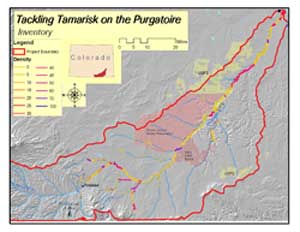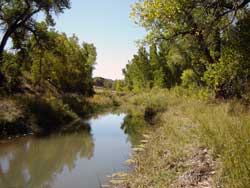La Junta Field Office – Tamarisk Management
Tackling Tamarisk on the Purgatoire is a collaborative project between public agencies, non-profit organizations and private landowners in the Purgatoire River Watershed.
Tackling Tamarisk on the Purgatoire River Watershed

Restoring the Ecosystem Along the River
Since 2004, Tackling Tamarisk on the Purgatoire (TTP) project partners have worked to improve native riparian communities along the Purgatoire River Watershed in southeast Colorado by removing non-native, invasive woody plant species, such as tamarisk (salt cedar) and Russian olive. In doing so, the project helps protect Colorado’s native riparian areas, water resources, watersheds and communities, as well as the wildlife and agriculture that depend on these resources.
The lower Purgatoire River Watershed encompasses more than 275 river miles, including the river and its tributary feeder streams. The main stem of the Purgatoire flows east from the 14,069-foot Culebra Peak high in the Sangre de Cristo Mountains to Trinidad, Colo. From there, the river flows northeast to Las Animas, Colo., where it converges with the Arkansas River.
The watershed supports one of the most intact native fisheries in the Central Shortgrass Prairie east of the Rocky Mountains. Fortunately, many areas in the Purgatoire Watershed still exhibit remarkably intact and vigorous native riparian vegetation, making restoration efforts more successful and sustainable.
Currently, the tamarisk infestation is fairly manageable, especially in the upper reaches of the river. Removing the invasive plant will cost substantially less at this point than it will if the plant is allowed to spread. Getting a head start on the tamarisk infestation has been critical to the control and long-term project success of the TTP partnership.
How Tamarisk Threatens the Watershed

The tamarisk invasion threatens significant riparian vegetation and degrades the ecosystem in the Purgatoire River Watershed in numerous ways by:
- Significantly increasing non-beneficial water consumption
- Crowding out native plant species
- Increasing salinity of the surface soil, which renders it unsuitable for other plants to grow
- Providing less diverse and lower-value habitat for wildlife
- Widening floodplains, clogging stream channels, and increasing sediment deposition
- Diminishing human enjoyment of and interaction with the river environment
Salt cedar and other invasive trees, such as Russian olive, also compromise the livelihood of Colorado’s agricultural community by consuming valuable water required for farming and ranching.
Wildlife use of tamarisk is very limited to nonexistent, as its seeds are too small for most wildlife to use, and the plants do not provide adequate nesting habitat. Tamarisk grows so thick in some areas that wildlife can hardly pick their way through the dense thickets—this is also true for people and livestock.
In many riparian forests, such as those in southeast Colorado, tamarisk has become a ladder fuel. This puts the forests and people who live in these watersheds at risk of unnaturally severe wildland fires, because tamarisk ignites easily and exhibits extreme fire behavior, including intense heat and rapid spread.
TTP Partners
TTP partner representatives include a broad range of public agencies, non-profit organizations, and individuals who have joined in this collaborative effort. Active partners include:
| Branson-Trinchera Conservation District (CD) | Colorado Department of Agriculture |
| Colorado Division of Wildlife | Colorado State Forest Service |
| Colorado Water Conservation Board | Natural Resources Conservation Service |
| Purgatoire River Water Conservancy District | Rocky Mountain Bird Observatory |
| Southeastern Colorado Water Conservancy District | Spanish Peaks-Purgatoire River CD |
| Tamarisk Coalition | The Nature Conservancy |
| Trinidad State Park | U.S. Bureau of Reclamation |
| U.S. Fish and Wildlife Service | Private landowners and many others |
Purgatoire River Tamarisk Map and Infestation Inventory

In 2005-2006, the Tamarisk Coalition, a non-profit alliance working to restore riparian lands, completed a comprehensive map for the Colorado Water Conservation Board that illustrated tamarisk infestations on the Purgatoire River Watershed. The map has allowed the TTP partners to identify and strategically attack the establishment and spread of tamarisk and other invasive plant species.
For more information, visit the Tamarisk Coalition website.
TTP Strategic Plan
A comprehensive strategic management plan for Tackling Tamarisk on the Purgatoire was completed and addresses issues in the watershed from Trinidad Lake in Las Animas County to the John Martin Reservoir, where the river converges with the Arkansas River in Bent County. The Consolidated Woody Invasive Species Management Plan for Colorado’s Purgatoire Watershed was approved by the Colorado Department of Agriculture Weed Coordinator and is available at the Arkansas River Watershed Invasive Plant Project website.
Project Implementation
In 2005, TTP partners were awarded Natural Resources Conservation Service (NRCS) Environmental Quality Incentives Program (EQIP) Invasive Plant Program funding. Three landowners currently are working under 10-year contracts with the NRCS. To date, 20 acres of tamarisk mitigation have been completed, with a total treatment goal of 100 acres.
Treating Tamarisk
Treatment methods used will be very site specific. In the upper end of the Purgatoire watershed, the project will mostly employ the cut-stump method (i.e., using a saw crew that includes a sawyer, sprayer, and stacker). After cutting all stems of a plant, herbicide is applied to the cut stumps within 10 minutes. This is a very low impact treatment method that spares existing vegetation. The cut stems are then stacked for disposal as determined by the landowner. Other methods used within the watershed’s upper reaches will include mechanical mulching, followed by foliar application after a season’s worth of growth.
The Tamarisk Leaf Beetle
A promising option for control is the tamarisk leaf beetle (diorhabda elongata). These beetles have been very successful on Colorado’s west slope, and the Colorado Department of Agriculture is currently working towards the release of a sub-species of the beetle that may have success on the eastern slope. The beetles do not outright kill tamarisk, but continually stress it, giving native vegetation the advantage and eventually causing death of tamarisk. Bio-control should be considered wherever feasible, as it causes no disturbance to soils or native vegetation and is the least costly of all control methods once established.
For more information, read about tamarisk and biological control with the leaf beetle (3.2 MB PDF).
Trinidad State Park
Trinidad State Park, one of the TTP partners, is located at the upper end of the watershed and southwest of Trinidad. With the partnership’s assistance, the park has treated nearly 170 acres along the waterways at Trinidad Lake. After treating the majority of tamarisk in the park, this partner annually monitors the areas for re-growth.
Chacuaco Creek
Chacuaco Creek is the largest tributary of the Purgatoire River and is located between the towns of Kim and Branson. The project goal is to control tamarisk and Russian olive within the entire drainage. The Colorado Division of Wildlife (CDOW) Wetlands Program awarded a grant to the Branson-Trinchera Conservation District (B-T CD) to initiate the effort, and 160 acres were treated in 2009. B-T CD recently was awarded two additional grants for 2010-2011: a CDOW Wetlands Grant for 2010, as well as a grant from the Colorado Water Conservation Board. The goal of the Branson-Trinchera Conservation District and the TTP partners is to treat 400 acres by 2011.
 |
 |
Riparian Restoration – The Ultimate Goal
Understanding how tamarisk and Russian olive function and respond to treatment within different environments will provide long-term success with removal and control efforts. Keys to success for the TTP project are to:
- Identify goals to remove, control and plan for restoration
- Develop a long-term plan that employs best management practices and control methods for individual sites
- Identify other invasive weeds that exist on individual sites
- Incorporate monitoring and maintenance of re-growth into the TTP plan
Recognizing that private landowners are instrumental to the success of the project, the team continues to work with landowners to provide them with the information they need to make informed decisions about how best to control tamarisk on their land.
The many partners recognize that this is a long-term effort, and sustainability of the Purgatoire River Watershed and its native fisheries, rare riparian plant species, agriculturally based communities, and recreational users relies on TTP’s success.
For more information about the Tackling Tamarisk on the Purgatoire Project, please contact the La Junta Field Office at (719) 383-5780.

